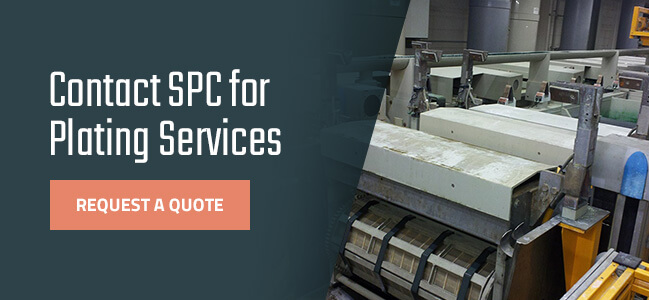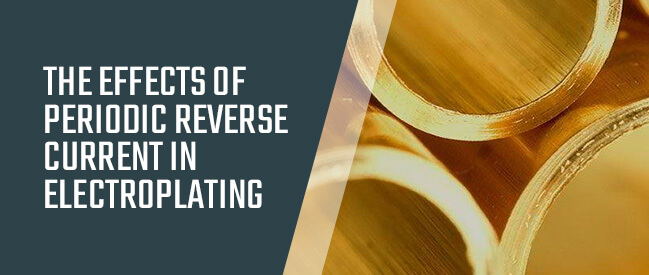
Electroplating is a trusted method for depositing metals onto part surfaces, but it comes in several varieties. Some are better suited to certain applications. One such option is periodic reverse current plating. This method occasionally adjusts the current flow direction to modify the metal’s deposition onto a surface. It helps address some challenges of standard direct-current (DC) electroplating and offers a better result while reducing the need for additives.
We’ll take a closer look at this style of electroplating, including what makes it different from DC electroplating and how different industries use it.
What Is Electroplating?
The electroplating process uses an electric current and an electrolytic solution to deposit a thin layer of metal onto a surface. It starts with a direct current applied to an anode, with a cathode waiting on the other side of the solution. The metal atoms oxidize, become positive ions and dissolve in a solution with one or more metal salts that facilitate the flow of electricity. The current moves the positive ions toward the negatively charged part, where they deposit onto its surface.
Metals used in electroplating include copper, tin, zinc, nickel, gold, silver and palladium, but alloys are also popular. Certain additives can impart desired properties such as conductivity, hardness and smoothing.
Between additives and the chemistry of the process itself, the end product usually has various improvements to its physical properties. You might use electroplating to improve corrosion resistance or ductility, for example. These adjustments depend on various factors, such as the electrolytic solution, the base material, the deposited metal and, as we’ll discuss, the type of current.
Many industries use electroplating to their advantage, including automotive, medical, oil and gas, aerospace and electronics. They use a wide range of electroplated products, like copper-plated semiconductors, palladium-plated catalytic converters and electroless nickel-plated aerospace components.
What Is Pulse Current?
With a direct current, a constant current — or potential — exists between the anode and the cathode. A pulse current is a non-direct current that delivers periodic pulses of current as it alternates between two different values. The pulses typically have equal amplitudes, durations and polarity and are separated by periods of zero current. The periods where current is applied are called on time or Ton, while the periods with zero current are called off time or Toff.
Overall, the pulse current delivers modulated or nonstationary waveforms. Since they have a more dynamic shape, pulse currents have more parameters, namely tunable on and off times. Because of these additional parameters, pulse current plating offers more control over the process, allowing for better results in properties such as:
- Diffusion layers: DC plating creates a diffusion layer around the cathode, which prevents potential adatoms from reaching the electrode’s surface.1 This interruption can slow the mechanical properties and growth rate of the metal deposits. The off-time in a pulse current dissipates the diffusion layer, allowing ions to distribute uniformly in the solution and deposit more efficiently and consistently. The result is less surface roughness of metal deposits.
- Grain size: The increased cathodic overpotential allows for higher current densities in pulse current plating, which in turn delivers faster nucleation rates and smaller grain sizes.2 Smaller grain sizes can offer higher compressive yield strength due to the Hall-Petch relationship.3
- Purity: Additives are often used to reduce grain size in DC plating, but these additives can adsorb at grain boundaries or planes and introduce impurities, which can affect the properties of the deposit.4 Since the pulse current process works through current modulation, it requires fewer additives, which can save on costs and material consumption.
- Porosity: Porosity occurs when microscopic defects appear in a coating, usually those that are less than 1.25 microns thick. By limiting thin areas and reducing surface roughness, pulse currents can help limit the chances of porosity appearing in a product.
Overall, a pulse current offers more options and can reduce the costs associated with additives, including material and disposal costs and labor requirements. This method of electroplating is common for products such as printed circuit boards (PCBs), semiconductors and composite materials.
What Is Periodic Reverse Current in Electroplating?
Pulse currents can be unipolar and share the same sign, or they can be bipolar and share a mixture of anodic and cathodic pulses.5 A periodic pulse reverse current (PRC) is a bipolar pulse current. It reverses the current flow from a forward-moving cathodic current to an anodic current for short periods. The overall movement still goes in one direction to provide net electrochemical activity, but these brief reversals affect how the material deposits on the surface.
A periodic reverse current can redistribute material deposition and create a smoother film. During the anodic pulse of PRC, the deposited surface partially redissolves, especially in areas of higher current density. This action helps to combat thicker deposits from the cathodic phase and level out protrusions, which can result in a more homogenous deposit overall.
Like pulse currents, PRC can also prevent thick diffusion layers that would impede the flow of ions. During the off time or the reversed pulse, this layer discharges more effectively, allowing ions to move easily. While pulse current methods can reduce the need for additives, PRC can bring consumption down to negligible values. Reduced additive use can help save costs and provide environmental benefits.
Both of these mechanisms help improve the physical properties of the metal. The reverse current preferentially removes dendrites6 — tree-like crystal structures7 — and can reduce polarization effects such as impurities from adsorption. In many ways, PRC enhances the impact of unipolar pulse currents, providing a more effective process with fewer resources required.
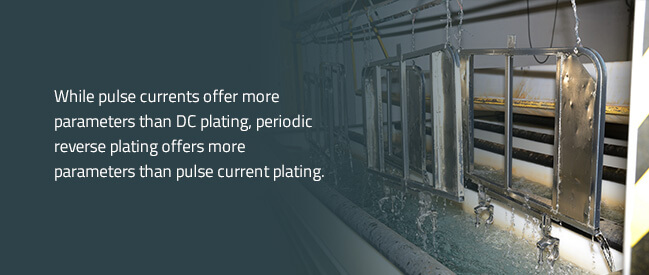
While pulse currents offer more parameters than DC plating, periodic reverse plating offers more parameters than pulse current plating. In addition to on and off times and cathode peak current density, a reverse current also needs anode peak current density and the duration of the cathode pulse.8 These extra parameters allow for more precise control over currents and the resulting characteristics of the deposited metal.
Direct Current vs. Periodic Reverse Current
DC and PRC plating are both appropriate in different contexts, but PRC tends to have an advantage in:
- Speed: DC plating involves preferential deposition on areas with high current density. Achieving minimum thicknesses can take more time and use more material, making it less efficient overall. PRC can avoid this outcome and reduce post-processing requirements.
- Flexibility: Complex geometries, like those used in PCBs, may face performance issues due to inconsistent plating from DC methods. With PRC, you can adjust more parameters to ensure optimal performance and avoid excessive deposits in some areas, such as the outsides of holes.
- Labor and material usage: With a reduced demand for additives, PCR can limit the costs and disposal requirements associated with them. Faster plating also allows manufacturers to reduce labor demands and production time.
- Performance: Pulse plating is ideal for maximizing hardness and reducing porosity.9 These physical characteristics can improve performance in areas like yield strength and conductivity. DC tends to provide high leveling and bright covering power, but pulse plating has the advantage in uniformity and throwing power.
- Texture: In some cases, reverse pulses offer a highly oriented texture. The grain in copper, for instance, becomes more refined for better microhardness.10 This texture can contribute to improved corrosion resistance.
Reverse pulse plating is often the leading choice, with extensive benefits in PCB manufacturing and other applications that require uniform layers or involve complex geometries. Where performance is concerned, PRC offers advantages such as strength, corrosion resistance and smaller grain sizes.
How Periodic Reverse Current Affects the Electroplating Process
A periodic reverse current can impact many parts of the electroplating process, so choosing to use it requires careful consideration and understanding of the interactions it involves. Some of the influences of pulse reverse currents include:
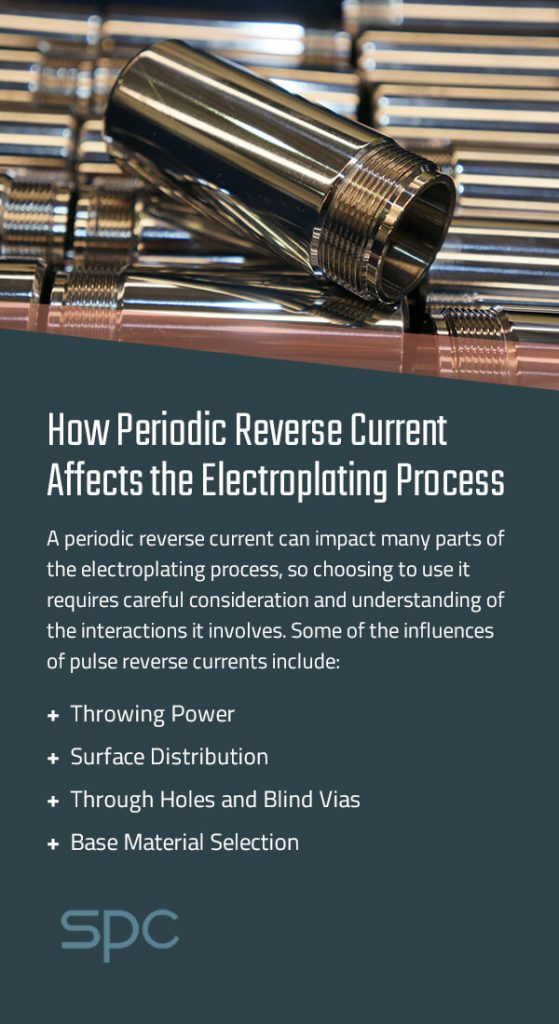
1. Throwing Power
Throwing power refers to a solution’s ability to plate to a uniform thickness across an irregularly shaped piece. Typically, the throwing power of high-frequency pulse reverse plating is hard to predict due to transient effects. These situations may require additives that increase the solution’s polarization resistance.
Additives can respond in unique ways, and some can cause reduced polarization resistance. Choosing the right ones is a crucial part of allowing the solution to achieve high polarization in regions with high current density and low polarization in those with low current density.
2. Surface Distribution
Throwing power can influence the amount of material required for plating, so it heavily impacts surface distribution. If surface distribution is uneven, increased thickness in certain areas can increase costs and affect performance. Take circuit boards, for example. A thick coating can reduce the performance of high-frequency signal transmission. By improving surface distribution, manufacturers can ensure more even performance across the circuit board.
Comparing unipolar pulse plating and DC plating at the same average current density, the DC plating technique tends to offer better throwing power. Pulse reverse plating, however, can achieve much better throwing power than DC, even at higher average current densities.11 Frequency and additives make little difference in the throwing power of a pulse reverse plating technique, so it can help achieve even distribution even with metals and solutions that require specific configurations.
3. Through Holes and Blind Vias
One of the more popular applications for pulse reverse plating is in printed circuit boards, which rely on a good hole-to-land thickness ratio for reliable performance. Achieving a minimum specified thickness in through holes is usually the last design parameter fulfilled in plating.11 Miniature PCBs also require blind vias in high-density interconnect outer layers. Agitation is a crucial component of plating onto these blind vias. Jet plating, for instance, can help fill the vias efficiently.
An optimized pulse reverse current process can improve throwing power in through holes and over patterned panels. Certain additives can also help improve the ductility of the coating over DC plating methods and reduce its intrinsic stress, primarily by controlling anodic current density.
Overall, the reverse pulse plating method can help address common plating problems associated with proper distribution along through holes and blind vias.
4. Base Material Selection
Researchers have tested pulse plating with a wide range of alloys to find the ideal parameters for electroplating. Typically, for independent alloy deposition, the more noble metal gets plated until it reaches a surface concentration of zero. The less noble metal then gets discharged. Different parameters can affect whether the noble metal concentration reaches zero at the surface of the electrode, and the plating process must consider this potential variation.11
For an alloy to form, the surface concentration of the noble metal must reach zero, but low peak currents and high concentrations of the reacting component in the solution can increase the amount of time it takes for the noble metal to reach zero. By keeping peak currents high, we can avoid excessive graduations in metal compositions. The speed of a reverse pulse method also helps to achieve proper concentrations and ensure the deposition of the second metal and the formation of the alloy.
Types of Industry Parts Made From Periodic Reverse Current
You can use periodic reverse current plating on many of the same parts in which you would use other plating methods. You might, for instance, use reverse current plating for depositing a metal with low throwing power. The improved throwing power of the reverse current method can make up for the metal’s other characteristics. With more parameters to control, pulse reverse plating can offer more flexibility and options for industries with unique specifications.
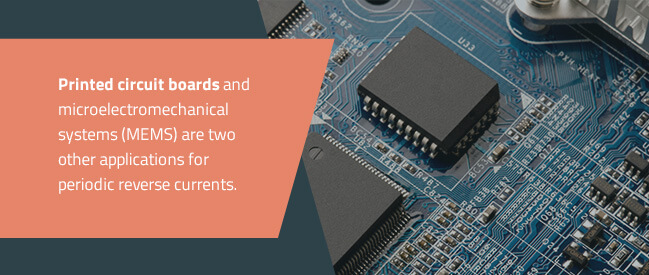
Printed circuit boards and microelectromechanical systems (MEMS) are two other applications for periodic reverse currents. This process can overcome complex geometries and demanding performance requirements in an efficient, cost-effective manner.
While this technique is common in PCBs and semiconductors for various consumer products, it also offers the specificity and performance required to meet strict or complex demands for certain parts.
Other industries in which you’ll find components made with pulse reverse current plating include:
- Aerospace and aviation
- Military and defense
- Medical equipment
- Optics equipment
- Oil and gas
- Power generation
Contact SPC for Plating Services
Periodic reverse plating is a powerful technique, but it is highly specific and involves many different factors. If you plan to use it, you’ll need the help of experienced plating professionals. SPC has been perfecting the art of electroplating for over 90 years. We offer a full-service plating facility, complete with a wide range of plating methods to choose from. We can also coat or finish your parts and provide consulting services to help you find a high-performing, cost-effective, environmentally friendly plating solution.
To see how SPC can help you tackle pulse reverse current plating, request your free quote today.
Sources:
- https://www.nmfrc.org/pdf/psf2001/01jun60.pdf
- https://www.intechopen.com/chapters/63479
- https://lwlin.me.berkeley.edu/me138/paper4.2.pdf
- https://www.researchgate.net/publication/322903483_Electrodeposited_copper_using_direct_and_pulse_currents_from_electrolytes_containing_low_concentration_of_additives
- https://www.nature.com/articles/s41598-022-22650-x
- https://www.chemeurope.com/en/encyclopedia/Periodic_current_reversal.html
- https://www.chemeurope.com/en/encyclopedia/Dendrite_%28metal%29.html
- https://www.nature.com/articles/s41598-022-22650-x
- https://www.sciencedirect.com/science/article/abs/pii/S0026057605800753
- https://www.sciencedirect.com/science/article/pii/S2666523921000623?via%3Dihub
- https://www.hanser-elibrary.com/doi/book/10.12850/9783874803236


